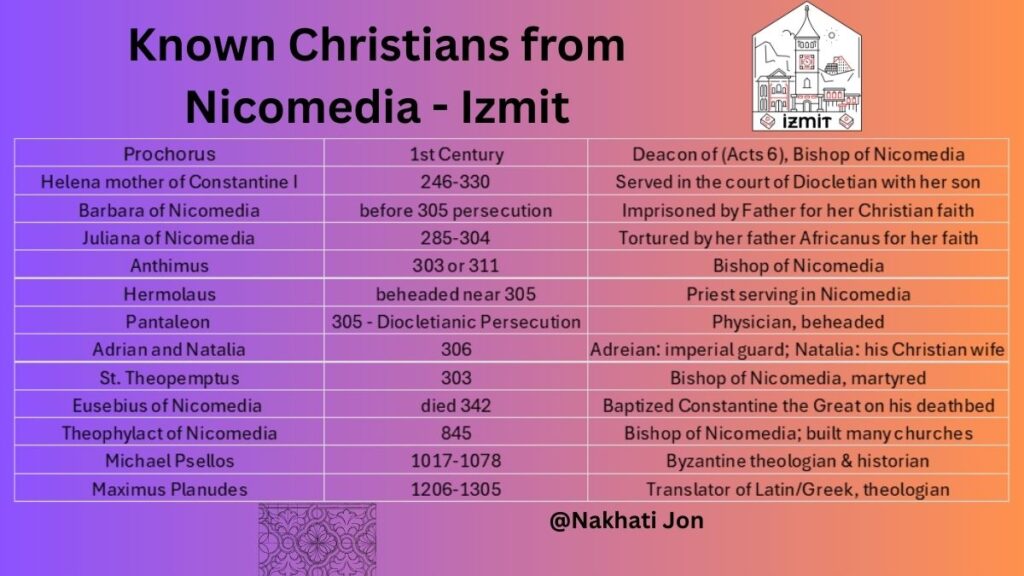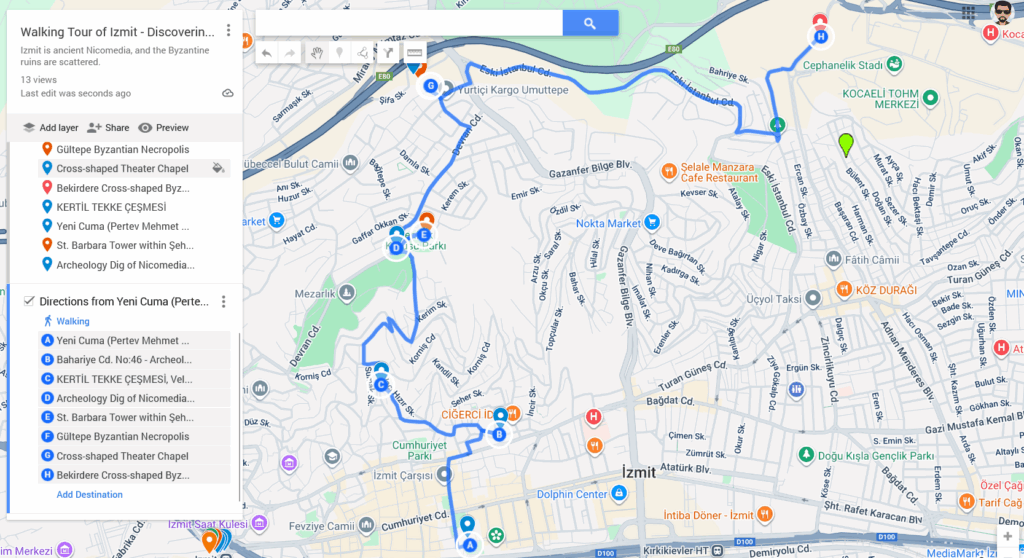Izmit, a vibrant city nestled in northwestern Turkey, is unknown for its rich Byzantine history. The city formerly called Nicomedia hosted the persecution of Christians under Emperor Diocletian and later became the birthplace of several notable Christians. Yet, today, this landscape lies buried and easily ignored.
When people think of Byzantine history, they often picture figures like Constantine or landmarks such as the Hagia Sophia. However, Nicomedia was actually the center of the Eastern Roman Empire during Constantine’s reign. This city played a crucial role in the early formation of Christianity, with important ties that trace back to the 1st century. Let’s explore this forgotten city, which largely remains unknown and has a history that lies hidden beneath the surface or has been destroyed by economic development.
First Century Church in Bithynia
Bithynia (Βιθυνία ) includes the ancient city of Nicomedia. Bithynia is mentioned twice in the New Testament (Acts 16:7 and 1 Peter 1:1). In Acts, Paul and his companions wanted to visit this area, but the Holy Spirit led them elsewhere.
Since Peter mentioned this area, it is possible, based on tradition, that Peter visited this area if he visited Galatia. Yet, the inclusion of this area in his writings means that he knew believers from this part of Asia Minor. Some have suggested the list of places demonstrates the route followed by those who will distribute the letter of 1 Peter so the early church had contacts in Nicomedia. 1 Peter 1:1-2 says, “Peter, an apostle of Jesus Christ, To those who are elect exiles of the Dispersion in Pontus, Galatia, Cappadocia, Asia, and Bithynia, according to the foreknowledge of God the Father, in the sanctification of the Spirit, for obedience to Jesus Christ and for sprinkling with his blood: May grace and peace be multiplied to you.” (ESV)
In Acts 6, a man named Prochorus (Acts 6:5) was appointed as a deacon. According to tradition, this man served in Nicomedia, Bithynia, sometime after this event.
Early Growth of Church in Nicomedia
The early church was started by the acts of the apostles and also we know that Pliny the Younger asked Trajan what to do about the Christians. This ruler oversaw Bithynia from 110 to 117 AD, so we know that by this question that quite a bit of Christian activity was taking place in this region.
Nicomedia, the home of Helena, Constantine’s mother, and the cruel emperor Domitian (Diocletianic Persecution, 303 AD). Also, the city became the first Eastern capital of the Roman Empire between 286 and 330 AD. This was before Istanbul was declared the capital by Constantine (Byzantium, later Constantinople) .
Yet, this Christian persecuting emperor, Diocletian, could not stop the growth of Christianity in his hometown. Helena, who promoted the Christian faith, most likely influenced the freedom of the church in ancient Nicomedia. From the 4th century on, the church has existed publicly, but today, very minimal outward evidence exists.
Known Christians from Nicomedia

After the emperor’s victory in Africa, the city celebrated by offering sacrifices to the gods and performing actions that acknowledged the emperor’s divinity. The Christians, however, did not participate in these celebrations and became targets of persecution. As a result, churches were destroyed, scriptures were burned, and Christians had their legal rights stripped away. Notice churches were burned; this was before the Edict of Milan, which took place 10 years later. 3rd-century churches existed in many of these cities, and evidently, here, buildings were made.[1]https://nakhatijon.com/hidden-crosses-while-walking-thru-the-churches-of-ephesus/
During a Christmas gathering, the church members were trapped inside while authorities placed wood outside to burn them.[2]see https://www.youtube.com/watch?v=wNgXFFvqtQw Although this story may have been embellished over the years, even if only a part of it is genuine, it is clear that Nicomedia became a place of many martyrs. Among the known Christians listed, several died during this final wave of persecution in the Roman Empire.[3]https://www.oca.org/saints/lives/1999/12/28/103664-20000-martyrs-of-nicomedia
The City of Declaration
Death and martyrdom became the call of Christians in and around 303, and so much so that the list of martyrs from this city seems endless. Yet, Galerius, the eastern Roman emperor, declared from this city the Edict of Tolerance that ended the persecution of Christians. He was a key figure in Diocletian’s Tetrarchy and was involved in the persecution of Christians, but in 311, the wave of influence changed. This man, Galerius, died in Nicomedia in 311 AD from a sickening disease (possibly some gangrene or cancer) that painfully deformed his body. In his last days, out of fear, he humbly issued the edict, hoping for some divine grace for healing. The man who tortured and killed many Christians died a more painful death than many of them.
The result of the persecution led to very few remaining in the city. Previously, the number of Christians numbered in the thousands in Nicomedia, but at the time of the edict, it was very few. Yet, 14 years later, at the Council of Nicaea, Eusebius of Nicomedia came from this city, showing that the Christian influence remained. During that time, he was the bishop to the Imperial Court, so a man of considerable influence.
Map of potential finds:

Nicomedia or Nicaea?
So at the time of the First Ecumenical Counsel of Nicaea, Constantine just defeated Licinus in the Battle of Chrysopolis (Uskudar) which was fought in 324 AD. He was in the process of making Byzantium his capital, but Nicomedia was still the capital at the time, despite the emperor residing in Byzantium. Constantine represented the Western Roman power, while Licinus represented the Eastern power. At this battle, Constantine became the sole emperor. In a move to minimize Licinius’ power, Constantine initiated the meeting of Nicaea, in the backyard of the capital, since Licinius had banned the ecclesiastical meetings of bishops when he was in power. The two cities saw this political rivalry firsthand, which eventually made Nicaea famous and Nicomedia a forgotten backyard.
Nicomedia Metropolitan
Elevation to Metropolitan See: In 451 at the council of Chalcedon, the bishopric was elevated to a metropolitan see under the Ecumenical Patriarchate of Constantinople and ranked 7th among its metropolitan sees—a clear sign of a well-established ecclesiastical structure. This would mean that the key pastor in this city would be called the Archbishop and would oversee multiple churches in the region. He would answer directly to Constantinople wit,h only six regions considered more influential than here.
By the 5th century, Nicomedia oversaw the following areas:
- Nicaea (İznik) – since Nicomedia was the capital of Bithynia, they took prominence over this town.
- Chalcedon (Kadıköy) – site of the 451 council where the decision was made.
- Prusa (Bursa) – an important Bithynian city to the west, where multiple churches existed.
- Apamea Myrlea (Mudanya) – a regional port town with a natural harbor.
- Helenopolis (Yalova). Still today, there remains a ruined Byzantine church at this location, and the “Kara Kilise” (located in Çiftlikköy, Yalova).
- Drepanum (later Helenopolis, birthplace of St. Helena). Located on the southern shore where the new bridge connects Istanbul with Yalova.
- Cius (Gemlik) – the location of St. Aberkios Monastery (Elegmoi / Heliou Bomon) and Panagia Pazariotisa church which now Gemlik Balıkpazarı Mosque.
- Prainetos (modern Karamürsel area). Graves and an archway remain in that area.
- Other smaller coastal and inland towns of Bithynia, any other coastal towns that had a bishop would fall under the oversight of Nicomedia.
Nicomedia’s fall from Influence
From 700 to 1000, the port of Nicomedia was a military port that hosted regiments that protected the area from Arab invasions. This area was the first line of defense, so the political influence waned and the military forces came and went. Eventually, with the coming of the Seljuks, Crusades, and Ottomans, the city just became an essential port for whoever controlled the region.
This series will explore the Byzantine sites of Izmit.
Leave a Reply